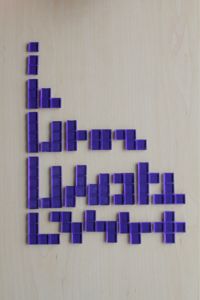Blokus Rules and Instructions
First, peek inside the brightly colored box. There, you'll find 84 geometrically shaped game pieces in 4 distinct colors (21 in each color), a 400-square board and an instruction booklet.
As we mentioned, some of those pieces might look strangely familiar to Tetris fans. Here's why -- All 21 pieces represent different types of polyominos, geometric shapes made up of unit squares that border each other in various patterns [source: Weisstein]:
Advertisement
- 1 piece consisting of 1 square (monomino)
- 1 piece consisting of 2 squares (yep, it's a domino)
- 2 pieces comprised of 3 squares (triominoes)
- 5 pieces made up of 4 squares (tetrominoes, your old buddies from Tetris)
- 12 pieces made up of 5 squares (pentominoes)
So, the goal of Blokus is to put all 21 of these babies on the board. Sound easy? Consider that there are only a certain number of legal placements.
Let's say you picked blue, so it's your turn first. (The game is always played in order of blue, yellow, red and green turns, no matter what, and play proceeds clockwise). Start by placing a piece in the corner of your choice -- note that one square unit of your inaugural game piece must actually cover the corner square of the board. Your fellow players will then do the same with their respective corners. On each subsequent turn, each player will strategically place his or her Blokus pieces on the board. Two rules govern placement of pieces:
- You must position your piece so that it touches another piece of your same color.
- Those pieces CANNOT touch sides; they can only meet at corners.
In other words, you can't simply jam the pieces together like a puzzle (or Tetris). The pieces can touch the sides of your opponents' different colored ones, but -- again -- only if one corner of your piece is touching a corner of another piece belonging to you.
Best-case scenario, you'll be able to fit all your pieces on the board. If you're new to Blokus (or simply not a born Blokus prodigy), you'll run out of eligible moves before you run out of pieces. In that case, you're done playing. But just wait to see how the game ends, because each block (or covered unit square) you've played scores you a point at the end of the game.
When all the players have been foiled, the game is over. Count up all the squares on the board for a point each and then subtract your unused squares from that total. In other words, +1 for each square on the board, -1 for each unused square. If you were some kind of amazing Blokus genius and placed all 21 squares, good for you: You get 15 extra points! If you were even more amazing and managed to use the single square on your very last turn? Add another five points to that 15. You, my friend, are a Blokus champ.
